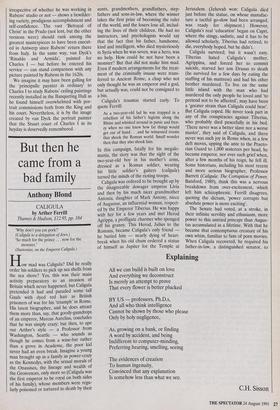Proclaiming a genius
Gregory Martin
VAN DYCK PAINTINGS by Arthur K. Wheelock Thames & Hudson, £48, pp.384 The recent loan exhibition of paintings and oil sketches by Anthony van Dyck at the National Gallery of Art in Washington was a wonderful affair, the like of which has not been seen before. Wonderful because, for the aficionado, the genius of van Dyck, for so long assumed, was at last proclaimed: here is indeed a great Baroque artist from Antwerp who holds his own with the likes of Reni, Domenichino and Guercino — now so very much in fashion — let alone with his mentor, Rubens.
Of all the phases of van Dyck's hectic and always brilliant career, i his English period, encompassing nearly the last decade or so of his life (during which he returned twice to Antwerp and visited Paris, which he left, ill, to die shortly after- wards in 1641 in London), has been recent- ly well surveyed in the rather cramped exhibition space at the National Portrait Gallery. In 1980 there was organised in Ottawa an exhibition devoted to the young van Dyck in Antwerp. For pictures by van Dyck in Genoese collections — Genoa being the main base of his activity during 'I've had him muzzled.' his stay in Italy from 1621-27 — memories have to be even longer, back to 1955. Amazingly, there has been no exhibition devoted to his activity back in the Nether- lands after his return from Italy and before his move to England. In this, his 'second' Antwerp period, van Dyck was at the height of his powers.
The achievement of the Washington exhibition was simply that all these phases in the artist's career were covered. So for the first time the full range of his genius from youth to middle age, when death struck him down, was illustrated by just over 100 on the whole superlative examples of his work.
The catalogue of the exhibition compiled by Arthur Wheelock of the Washington National Gallery and Susan Barnes of the Dallas Museum of Art, with Julius Held, the doyen of Flemish Baroque studies con- tributing the small section devoted to the oil sketches, contains a mass of information to be culled from eight introductory essays, six the work of other scholars, and then, from (for the most part) illuminating entries on the exhibits. There are two further bonus points in the form of an index and excellent colour illustrations.
As an exhibition catalogue it had the usual fault of being too weighty and long to be a useful vade-mecum for the visitor; as a book it suffers from the other fault endem- ic to the genre, namely that entries are often compiled without the benefit of lengthy study of the loaned exhibits in a conservation studio. Thus inscriptions have to be taken .on their face value and unless analytic photography has been previously undertaken by the lender, the paint surface too has to be taken at face value, with no knowledge of the creative process that brought it about.
The first exhibit may well prove a casual- ty. If the inscription is to be believed, this portrait was painted by van Dyck when he was 14. Yet the inscription and background paint on which it lies need proper examina- tion and may not be reliable. This would not undermine Susan Barnes' tendentious account of the young van Dyck, whose development and relationship with Rubens remain fascinating but divisive issues.
She takes the view that the young genius who became an apprentice to the second- rate but accomplished Hendrick van Balen in 1609 early gravitated towards Rubens and spent his time in Rubens' studio as an assistant both for some years before and after he became an independent master in 1618. Until more archival work has been undertaken (little has been done since the last world war, although some interesting work is about to be published) and until more of van Dyck's early paintings are analysed by x-radiographs, it is probably asking too much to obtain a convincing sequence for his early masterpieces. It is for these reasons that Susan Barnes' certi- tudes should be treated with caution.
Van Dyck's style in the early years — irrespective of whether he was working in Rubens' studio or not — shows a bewilder- ing variety, prodigious accomplishment and self-confidence. The vast 'Betrayal of Christ' in the Prado (not lent, but the other versions were) should rank among the greatest masterpieces to have been execut- ed in Antwerp since Rubens' return there from Italy. In the same way, van Dyck's `Rinaldo and Armida', painted for Charles I — but before he entered his service — can stand comparison with any picture painted by Rubens in the 1620s.
We imagine it may have been galling for the `principalle paynter in ordinary' to Charles Ito study Rubens' ceiling paintings recently installed in the Banqueting Hall as he found himself overwhelmed with por- trait commissions both from the King and his court. Nevertheless, it is by the image created by van Dyck the portrait painter that the Stuart court of Charles I in its heyday is deservedly remembered.



















































 Previous page
Previous page